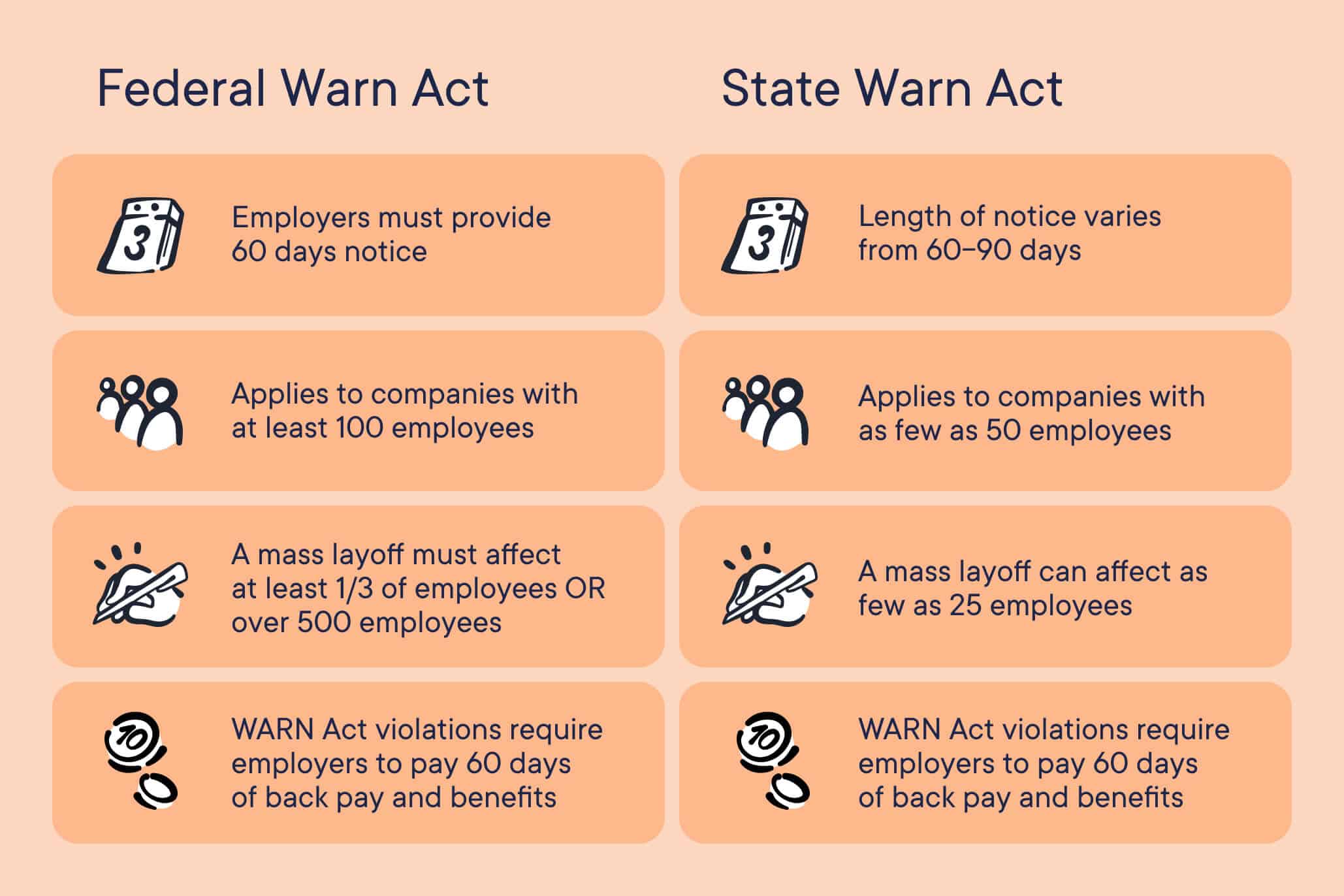
Preparing for a RIF?
Download our Essential Guide to Handling a Layoff
Request Pricing
Compare our rates to other providers
If you are planning to lay off employees in the state of Texas, you will need to make sure that you comply with all regulations pertaining to the Worker Adjustment and Retraining Notification Act (commonly known as the WARN Act). The WARN Act ensures that your employees are treated fairly and that you are not penalized for your layoff or reduction in force (RIF) event.
To make sure that you are compliant with the WARN Act in Texas, you will need to understand three different areas of these laws:
- The federal WARN Act requirements
- The state-specific Texas WARN Act requirements
- How to comply with Texas WARN notices
Before we get into our analysis for each of these areas, make sure to download our simple WARN Act checklist with the link below:
What Is the WARN Act in the US?
The WARN Act has several regulations that shape who the law should be applied to. This includes the following stipulations:
- The WARN Act applies to organizations that have over 100 full-time employees.
- The WARN Act applies to publicly and privately held companies.
- The WARN Act applies to organizations that are for-profit or not-for-profit.
- A WARN notice must be given if there is a plant closing or a mass layoff.
The first three stipulations are relatively straightforward. If you are an organization that has less than 100 full-time employees (FTEs), you do not have to comply with the WARN Act. If you have over 100 full time employees, the WARN Act will apply to you regardless of whether your organization is public or private, and for-profit or not-for-profit.
The final stipulation can be a bit trickier, since it relies on understanding the federal definitions of a “plant closing” and “mass layoff.”
According to the US Department of Labor (DOL), a “plant closing” is defined as:
“the permanent or temporary shutdown of a single site of employment, or one or more facilities or operating units within a single site of employment, if the shutdown results in an employment loss at the single site of employment during any 30-day period for 50 or more employees excluding any part-time employees.”
The federal WARN Act also defines a “mass layoff” as:
“a reduction in force which results in an employment loss at the single site of employment during any 30-day period for (i) at least 33 percent of the employees (excluding any part-time employees), and at least 50 employees (excluding any part-time employees); or (ii) at least 500 employees (excluding any part-time employees).”
Lays off 500 or more workers (not counting part-time workers) at a single site of employment during a 30-day period; or lays off 50-499 workers (not counting part-time workers), and these layoffs constitute 33% of the employer’s total active workforce (not counting part-time workers) at the single site of employment.”
Now let’s dive into how this applies at the state level for the Texas WARN Act.

Does the WARN Act Apply in Texas?
The short answer is yes, the WARN Act still applies in the state of Texas. All US states must abide by the federal WARN Act regulations explained above. In addition to that, some states do have more stringent regulations specific to companies or employees located in their state.
However, Texas is among those states which do not have their own differing WARN Act regulations. This means that Texan companies and/or employees who are part of a mass layoff or plant closure are still covered under the federal WARN Act and must follow all federal regulations to be compliant.
Texas WARN Act Examples
To help spell this out a bit further, here are a couple of examples of when the WARN Act might apply in the state of Texas.
- A manufacturing company located in Houston, Texas has 75 employees. The organization is laying off over half of its employees due to the loss of a business contract.
Since this company has less than 100 employees, it does not have to give a WARN notice.
- A non-profit organization with over 500 employees will be closing down an office in Dallas, resulting in 134 employees being permanently laid off.
Since this company has more than 100 employees, and the closing of that facility will affect more than 50 employees for more than 30 days, giving a WARN notice is required here.
Now let’s dig into how Texas companies should comply with the WARN Act if their reduction event qualifies.
Texas WARN Notices: How To Comply
To comply with the WARN Act in Texas, you will need to send a WARN notice letter to your affected employees 60 days in advance of their last day with the organization. This is the same as stipulated at the federal level.
This notice can be sent through several different delivery methods, as long as it is given in writing. The US Department of Labor (DOL) states that any reasonable method of delivery is applicable.
However, the US DOL also clarifies that, “Use of preprinted notices that are regularly included in employees’ paychecks or pay envelopes are not acceptable and do not meet the WARN Act requirements.”
This means that if your organization regularly gives out notices about the workplace to your employees with their paychecks, then providing a WARN notice this way will not be sufficient. This is because your employees might not distinguish this WARN notice from the other notices they regularly receive through this delivery method.
Your organization must also provide a notice to your government about your reduction event. Similar to the notice given to your employees, this notice must also be delivered at least 60 days in advance.
As the US DOL states, “Advance notice should be given to the State Rapid Response Dislocated Worker Unit as well as to the chief elected official of the local government where the closing or mass layoff is to occur.”
For information on who to notify in Texas of your layoff event, visit the Texas Workforce Commission website.
State Laws Impacting Your Layoffs
As we explained above, Texas does not stipulate any specific WARN laws other than the requirements set in the federal WARN Act. This means that if your organization and all of your impacted employees are located anywhere in Texas, you would only need to comply with these federal regulations.
However, in today’s increasingly connected world, there is a chance that you have impacted employees and/or plant closures located across more than one state. If you plan to lay off employees in multiple states, it is crucial that you research the individual state laws for each location–even if the majority of your employees or your headquarters are located within Texas.
In these cases, the smartest strategy is to identify the state with the most restrictive laws where you will be giving WARN notices, and then follow those regulations for all of your impacted employees across all states.
For example, if your company is headquartered in Texas with over 100 employees, and is conducting a mass layoff or plant closing as defined above, you would need to comply with federal WARN Act regulations.
Let’s say, however, that some of those impacted employees are located in New Mexico, California, or work remotely in New York. According to the Employment Law Handbook, New Mexico is similar to Texas in that there are no state regulations for local organizations besides the federal WARN laws.
However, California and New York do have extra state regulations that must be complied with. So you would want to research the California and New York WARN regulations to see which are more stringent and apply those to all of your impacted employees.
Now while there might not be any state regulations in Texas to dictate how layoffs must be structured, it is worth noting that your organization might qualify for special Texas programs to help organizations with reduction events.
For example, the Texas Shared Work program provides Texas employers with an alternative to layoffs by helping organizations to supplement their employees’ lost wages due to reduced work hours with unemployment compensation.
Always consult with your legal counsel when preparing to conduct a layoff event or researching laws regarding layoffs in your area to see what local, state, and federal laws or programs may apply to your specific situation.
Texas WARN Notices: Final Takeaways
While the WARN Act may be simple enough to understand both in Texas and at the federal level, it’s still important to stay informed on the most current regulations when your organization needs to comply.
This guide covered many of these specifics, but the law is constantly evolving year after year. So be sure to refer to the US Department of Labor and Texas Workforce Commission websites for the most comprehensive and up-to-date explanation of the law.
For information on the specific WARN Act requirements in other states that may apply to your organization, especially those that may go above and beyond the federal WARN regulations, see our similar WARN Act state guides for New York, New Jersey, Illinois, and California.
It can also be extremely helpful to offer outplacement services to employees who are affected by a plant closing or mass layoff event in areas of Texas such as Dallas or Houston. These services can help support their transition and provide a solution for any issues that may arise.
Be sure to consult with your legal team and company stakeholders about what solutions might be right for your organization to help you navigate the complexities of your reduction event and ensure you are following all applicable local, state, and federal laws.
In need of outplacement assistance?
At Careerminds, we care about people first. That’s why we offer personalized talent management solutions for every level at lower costs, globally.



